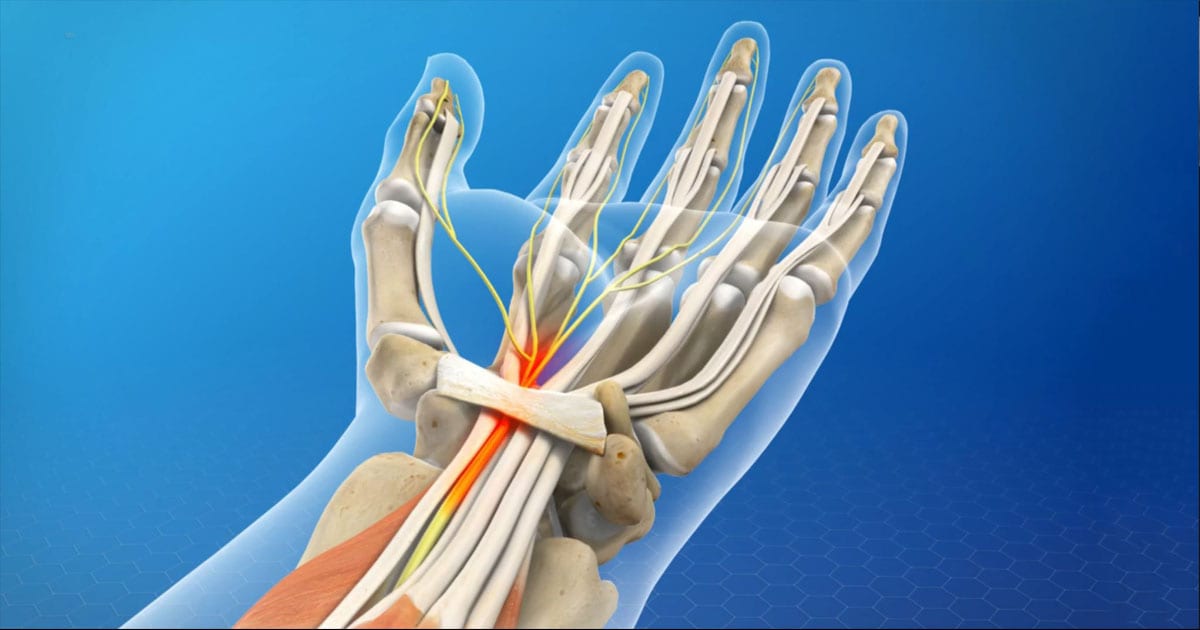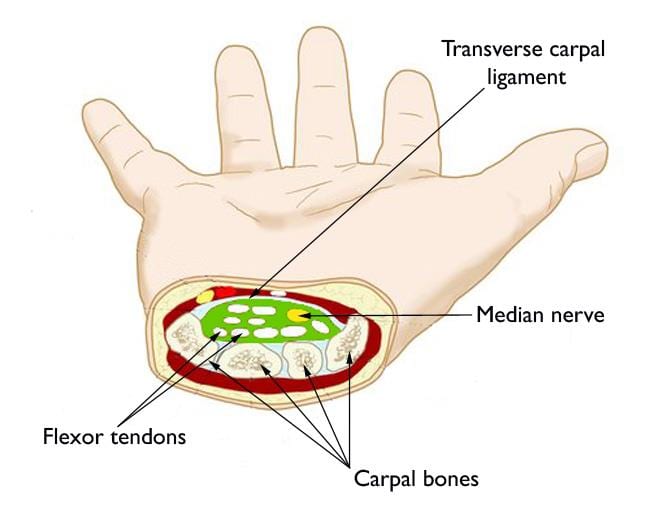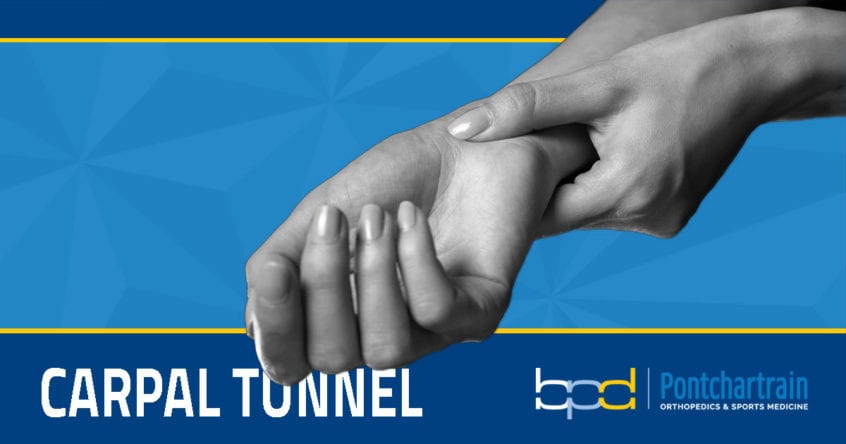
If you’ve ever struggled to open a jar or found yourself dropping things more than usual, there may be a very real explanation - carpal tunnel syndrome (CTS.) Years of working with your hands or banging away at a computer keyboard will take a toll, making everyday movements excruciatingly difficult and painful.
For today’s post, hand specialist Brandon P. Donnelly, MD explains this painful condition and the latest treatment options.
Is carpal tunnel syndrome common?
Yes. If you are experiencing chronic wrist pain, you’re definitely not alone. In fact, you might be surprised to learn that each year, carpal tunnel syndrome affects 1 in 3 people in the United States. The pain from this syndrome can range from a little discomfort when you make a fist to pain so severe you can hardly use your hands.
Anatomy of the carpal tunnel
FIrst, let’s start with the tunnel in your wrist. The floor and sides of the carpal tunnel are made up of small bones in your wrist called the carpal bones. The top, or roof of the tunnel is created by the transverse carpal ligament.
Because bone and tendons are rigid, the tunnel is unforgiving - with no room to "stretch" or increase in size.

The main nerve in the hand - the median nerve and nine "flexor" tendons all travel through this tight, rigid tunnel and into your hand.
The median nerve and flexor tendons are critical because together, they allow you to flex and have feeling in all of your fingers, except your pinky finger.
What is carpal tunnel syndrome?
The carpal tunnel is extremely narrow--about an inch wide--and protects the critical median nerve and surrounding tendons. However, because it’s so crowded in that tunnel, when there is an injury or inflammation, the median nerve can easily become irritated or pinched.
CTS occurs when swelling or an injury causes a chronic pinching of the median nerve at the wrist. And when a nerve is pinched or irritated, it causes pain.
Symptoms of carpal tunnel syndrome
The first sign that you might have CTS is when tasks you do with your hands become more challenging. Weakness in your hands may prevent you from opening jars.
Wrist pain, numbness or burning in your fingers may force you to take frequent breaks from typing on your laptop. These symptoms are worth paying attention to because they may be early warning signs of carpal tunnel syndrome.
Other symptoms of CTS may include:
Most of the symptoms of CTS begin gradually and may come and go at first. However, as the condition worsens, the symptoms may happen more frequently and for longer periods of time.
What causes carpal tunnel syndrome?
There are a few common factors that make you more likely to develop CTS. Women and older people are typically more at risk.
Anatomy
If you’ve ever dislocated your wrist or have arthritis, the inside of your wrist might be affected. It could be smaller or the bones could be deformed so that you might be more susceptible to carpal tunnel syndrome.
Gender
Because women have smaller wrists, their carpal tunnel area is also smaller. This means it’s more likely that there will be crowding in the tunnel that leads to increased pressure on the median nerve.
Nerve or inflammatory conditions
Most people don’t associate nerve or inflammatory conditions with carpal tunnel syndrome, but they could certainly affect your nerve. Inflammation, in particular, can impact the tendon linings and this adds pressure to the median nerve.
Work-related activity
Working on a computer, with vibrating tools, or on an assembly line might make you likely to suffer from repetitive motion damage. And if you already had nerve damage, these kinds of repetitive actions could just make it worse.
"Most people don’t associate nerve or inflammatory conditions with carpal tunnel syndrome, but they could certainly affect your median nerve."Brandon P. Donnelly, MD
Carpal tunnel treatment options
Non-surgical treatment
When diagnosed early, the symptoms of carpal tunnel syndrome may be relieved by simply limiting or modifying certain activities - like taking more frequent breaks to rest your hands. Rest, ice and splinting, combined with anti-inflammatory drugs or corticosteroid injections can effectively reduce the swelling and irritation of the median nerve. However, in more advanced cases, surgery may be required.
Open carpal tunnel surgery
Open carpal tunnel surgery has been the standard surgical treatment for chronic carpal tunnel syndrome. In open carpal tunnel surgery, pain and bleeding is controlled using a twilight anesthesia and a tourniquet wrapped around the arm.The transverse carpal ligament (the roof of the carpal tunnel) is carefully cut under direct visualization, creating more room for the median nerve. Open Carpal Tunnel Surgery
Endoscopic carpal tunnel surgery
Endoscopic carpal tunnel surgery is an alternative surgical option for carpal tunnel syndrome. This technique uses a scope for visualization and a special scalpel to release the transverse carpal ligament. The entire procedure can be accomplished through a minimally invasive incision at the wrist crease.The benefit of the endoscopic technique is a potentially smaller incision that avoids the thick palmar tissues. This often times translates into quicker recovery and less pain from the incision. Open Carpal Tunnel Surgery
WALANT carpal tunnel surgery
Another surgical method rapidly gaining popularity is WALANT (wide awake local anesthesia no tourniquet). In this procedure, the ligament is cut to create room; however, you remain awake and have fewer restrictions than traditional, open surgery. WALANT carpal tunnel surgery
There are various pros and cons regarding each technique and one may be better for you than another. Dr. Donnelly will discuss each option with his patients before scheduling their procedure.
Early diagnosis means more treatment options
While you may think you can manage the pain in your hand and fingers, ignoring it for too long can actually cause permanent damage. If you or someone you know is experiencing the symptoms of carpal tunnel syndrome, schedule an appointment with Dr. Donnelly today.
About Dr. Brandon P. Donnelly, MD
 Dr. Brandon P. Donnelly is a board certified orthopedic surgeon with Pontchartrain Orthopedics & Sports Medicine. Dr. Donnelly completed his hand and microsurgery fellowship at the prestigious Philadelphia Hand Center. Dr. Donnelly treats all ages of patients in the greater New Orleans area for hand, wrist, and elbow conditions. He has hospital appointments at East Jefferson General Hospital, where he is Vice-Chair of Hand Surgery and St. Charles Parish Hospital.
Dr. Brandon P. Donnelly is a board certified orthopedic surgeon with Pontchartrain Orthopedics & Sports Medicine. Dr. Donnelly completed his hand and microsurgery fellowship at the prestigious Philadelphia Hand Center. Dr. Donnelly treats all ages of patients in the greater New Orleans area for hand, wrist, and elbow conditions. He has hospital appointments at East Jefferson General Hospital, where he is Vice-Chair of Hand Surgery and St. Charles Parish Hospital.
This site is not intended to and does not provide medical advice, professional diagnosis, opinion, treatment or services to you or to any other individual. Through this website and links to other websites, Brandon P. Donnelly, MD provides general information for educational purposes only. The content provided in this website and links, is not a substitute for medical care or treatment. You should not use this information in place of a consultation or the advice of your healthcare provider. Brandon P. Donnelly, MD is not liable or responsible for any advice, course of treatment, diagnosis or any other information, services or product you obtain through this site.

